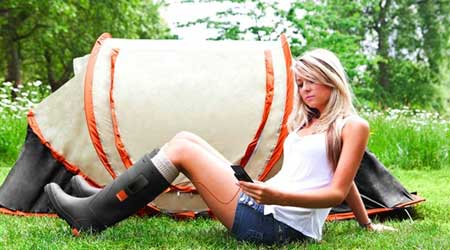 |
|
A girl wearing a pair of power boots. Modern festival-goers who dread ending up with a dead mobile phone battery after days stuck in a muddy field with no electric plug power points may now have a solution -- power boots. |
|
Modern festival-goers who dread ending up with a dead mobile phone battery after days stuck in a muddy field with no electric plug power points may now have a solution -- power boots. Mobile phone company European Telco Orange has introduced a phone charging prototype -- a set of thermoelectric gumboots or Wellington boots with a 'power generating sole' that converts heat from the wearer's feet into electrical power to charge battery-powered hand-helds. The boot was designed by Dave Pain, managing director at GotWind, a renewable energy company. Pain said the boot uses the Seebeck effect, named after physicist Thomas Johann Seebeck, in which a circuit made of two dissimilar metals conducts electricity if the two places where they connect are held at different temperatures. "In the sole of the Wellington boot there's a thermocouple and if you apply heat to one side of the thermocouple and cold to the other side it generates an electrical charge," Pain said. "That electrical charge we then pass through to a battery which you'll find in the heel of the boot for storage of the electrical power for later use to charge your mobile phone." These thermocouples are connected electrically, forming an array of multiple thermocouples (thermopile). They are then sandwiched between two thin ceramic wafers. When the heat from the foot is applied on the top side of the ceramic wafer and cold is applied on the opposite side, from the cold of the ground, electricity is generated. After a full day's festivalfrolics music lovers can plug their phone into the power output at the top of the welly and use the energy generated throughout the day to charge their phone. But the prototype boot does have one drawback. You need to walk for 12 hours in the boots to generate one hour's worth of charge. (Read by Lee Hannon. Lee Hannon is a journalist at the China Daily Web site.) (Agencies) |
喜愛(ài)參加節(jié)日活動(dòng)的人再也不用擔(dān)心被困泥地?cái)?shù)日遇上手機(jī)沒(méi)電,而且還找不到地方充電的尷尬情況了——一款充電靴可以解決這個(gè)問(wèn)題。 歐洲移動(dòng)運(yùn)營(yíng)商英國(guó)Orange公司最新推出了一款可以為手機(jī)充電的熱電橡膠靴或惠靈頓長(zhǎng)筒靴。這款靴子的底部?jī)?nèi)嵌發(fā)電裝置,可將穿鞋者腳部的熱量轉(zhuǎn)化為電能,為帶有電池的手提裝置充電。 這款靴子由GotWind可再生能源公司總經(jīng)理戴夫·佩恩設(shè)計(jì)。 佩恩稱(chēng),這款靴子主要根據(jù)以物理學(xué)家托馬斯?約翰?塞貝克的名字命名的“塞貝克效應(yīng)”設(shè)計(jì)而成,具體的原理是:靴底的兩種不同金屬接成一個(gè)閉合電路,然后利用它們所接觸部位的溫差在電路中產(chǎn)生電流。佩恩說(shuō):“長(zhǎng)筒靴的鞋底處有一個(gè)熱電偶,如果電偶的一面受熱,而另一面受冷,就會(huì)產(chǎn)生電荷。” “這些電荷會(huì)傳至鞋跟處的一個(gè)蓄電電池上,在需要時(shí)可為手機(jī)充電。” 這些熱電偶通過(guò)電力連接在一起,形成一系列的熱電偶(也稱(chēng)熱電堆),夾在兩塊陶瓷薄片之間。 當(dāng)腳部的熱量作用于上層陶瓷薄片,較冷的地面作用于下層的陶瓷片時(shí),電就產(chǎn)生了。 在一整天的節(jié)日狂歡后,音樂(lè)發(fā)燒友可以把手機(jī)插入長(zhǎng)筒靴頂部的電源插孔,利用一整天所產(chǎn)生的電能給手機(jī)充電。 但這款充電靴有一個(gè)問(wèn)題:你需要行走12個(gè)小時(shí),才能提供可供手機(jī)用一小時(shí)的電量。 相關(guān)閱讀 英國(guó)研制出一次性水溶婚紗 時(shí)尚且環(huán)保 英學(xué)生發(fā)明不變形擋風(fēng)雨傘和智能花盆 調(diào)查:卡拉OK機(jī)獲評(píng)“最煩人發(fā)明” 英國(guó):衛(wèi)星定位系統(tǒng)幫你找?guī)?/a> (中國(guó)日?qǐng)?bào)網(wǎng)英語(yǔ)點(diǎn)津 Julie 編輯蔡姍姍) |
|
Vocabulary: thermoelectric: of, pertaining to, or involving the direct relationship between heat and electricity(熱電的) frolics:嬉戲;狂歡 welly: Wellington boot(威靈頓長(zhǎng)筒靴;及膝膠靴) |
